
Lindow Man, also known as Lindow II and as Pete Marsh, is the preserved bog body of a man discovered in a peat bog at Lindow Moss near Wilmslow in Cheshire, North West England. The remains were found on 1 August 1984 by commercial peat cutters. Lindow Man is not the only bog body to have been found in the moss; Lindow Woman was discovered the year before, and other body parts have also been recovered. The find was described as "one of the most significant archaeological discoveries of the 1980s" and caused a media sensation. It helped invigorate study of British bog bodies, which had previously been neglected.

The Tollund Man is a naturally mummified corpse of a man who lived during the 5th century BC, during the period characterised in Scandinavia as the Pre-Roman Iron Age. He was found in 1950, preserved as a bog body, near Silkeborg on the Jutland peninsula in Denmark. The man's physical features were so well preserved that he was mistaken for a recent murder victim. Twelve years before his discovery, another bog body, Elling Woman, was found in the same bog.

A bog body is a human cadaver that has been naturally mummified in a peat bog. Such bodies, sometimes known as bog people, are both geographically and chronologically widespread, having been dated to between 8000 BCE and the Second World War. The unifying factor of the bog bodies is that they have been found in peat and are partially preserved; however, the actual levels of preservation vary widely from perfectly preserved to mere skeletons.
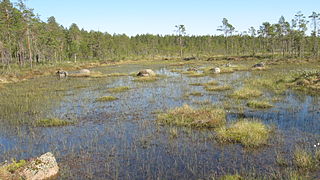
A bog or bogland is a wetland that accumulates peat as a deposit of dead plant materials – often mosses, typically sphagnum moss. It is one of the four main types of wetlands. Other names for bogs include mire, mosses, quagmire, and muskeg; alkaline mires are called fens. A baygall is another type of bog found in the forest of the Gulf Coast states in the United States. They are often covered in heath or heather shrubs rooted in the sphagnum moss and peat. The gradual accumulation of decayed plant material in a bog functions as a carbon sink.
Below are notable events in archaeology that occurred in 1952.
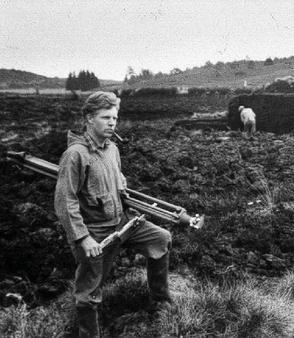
Peter Vilhelm Glob, also known as P. V. Glob, was a Danish archaeologist.
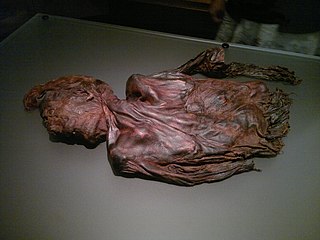
Clonycavan Man is the name given to a well-preserved Iron Age bog body found in Clonycavan, Ballivor, County Meath, Ireland in March 2003. The body shows signs of having been murdered. Theories around the meanings and manner of his death vary.

The Haraldskær Woman is the name given to a bog body of a woman preserved in a bog in Jutland, Denmark, and dating from about 490 BC. Workers found the body in 1835 while excavating peat on the Haraldskær Estate. The anaerobic conditions and acids of the peat bog contributed to the body's excellent preservation. Not only was the intact skeleton found, but so were the skin and internal organs. Scientists settled disputes about the age and identity of this well preserved body in 1977, when radiocarbon dating determined conclusively that the woman's death occurred around the 5th century BC.

Wintering Out (1972) is a poetry collection by Seamus Heaney, who received the 1995 Nobel Prize in Literature.
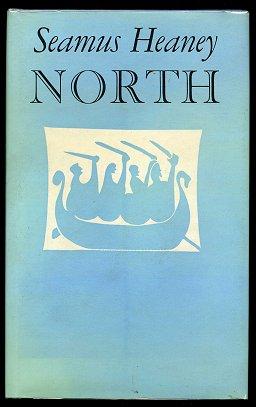
North (1975) is a collection of poems written by Seamus Heaney, who received the 1995 Nobel Prize in Literature. It was the first of his works that directly dealt with the Troubles in Northern Ireland, and it looks frequently to the past for images and symbols relevant to the violence and political unrest of that time. Heaney has been recorded reading this collection on the Seamus Heaney Collected Poems album.

Windeby I is the name given to the bog body found preserved in a peat bog near Windeby, Northern Germany, in 1952. Until recently, the body was also called the Windeby Girl, since an archeologist believed it to be the body of a 14-year-old girl, because of its slight build. Prof. Heather Gill-Robinson, a Canadian anthropologist and pathologist, used DNA testing to show the body was actually that of a sixteen-year-old boy. The body has been radiocarbon-dated to between 41 BC and 118 AD.

The Elling Woman is a bog body discovered in 1938 west of Silkeborg, Denmark. The Tollund Man was later discovered just c. 60 m (200 ft) away, twelve years after the Elling Woman's discovery. The Elling Woman was mistakenly described as a man in P. V. Glob's book, The Bog People, when it was published in 1965.

Osterby Man or the Osterby Head is a bog body of which only the skull and hair survived. It was discovered in 1948 by peat cutters to the southeast of Osterby, Germany. The hair is tied in a Suebian knot. The head is at the State Archaeological Museum at Gottorf Castle in Schleswig, Schleswig-Holstein.
The Kayhausen Boy is a mummy, naturally preserved in a sphagnum bog in Lower Saxony, Germany. He is one of the few recorded bog children discovered.

Gallagh Man is the name given to a preserved Iron Age bog body found in County Galway, Ireland, in 1821. The remains date to c. 470–120 BC, and are of a six-foot (1.8 m) tall, healthy male with dark and reddish hair, who is estimated to have been about 25 years old at the time of death. The presence of a withy hoop – rope made from twisted willow twigs – found wrapped around his throat indicates that he was strangled during a ritual killing or executed as a criminal.
Damendorf Man is a German bog body discovered in 1900 in the See Moor at the village Damendorf in Schleswig-Holstein, Germany.
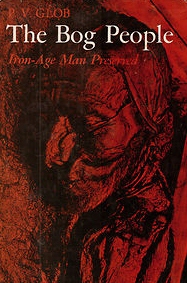
The Bog People: Iron-Age Man Preserved is an archaeological study of the bog bodies of Northern Europe written by the Danish archaeologist P.V. Glob. First published in 1965 by Gyldendal under the Danish title of Mosefolket: Jernalderens Mennesker bevaret i 2000 År, it was translated into English by the English archaeologist Rupert Bruce-Mitford and published by Faber and Faber in 1969. In 1966 it was translated into German by Thyra Dohrenburg and published by Winkler Verlag Munich under the title Die Schläfer im Moor.

"Punishment" is a poem by Irish poet Seamus Heaney first published in his 1975 collection North. It, along with "Bog Queen", "The Grauballe Man", "Strange Fruit" and "The Tollund Man", is inspired by P.V. Glob's book, The Bog People."Punishment" highlights similarities between Europe's ancient past and The Troubles in Northern Ireland.

A prominent position was held by wetlands and islands in Germanic paganism, as in other pagan European cultures, featuring as sites of religious practice and belief from the Nordic Bronze Age until the Christianisation of the Germanic peoples.




















